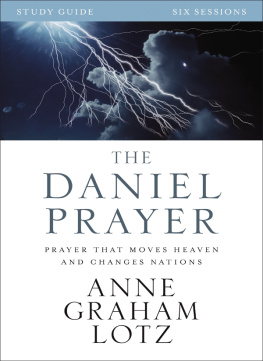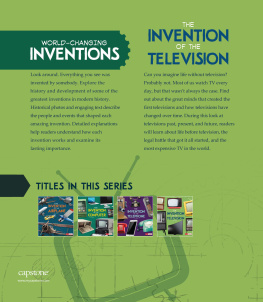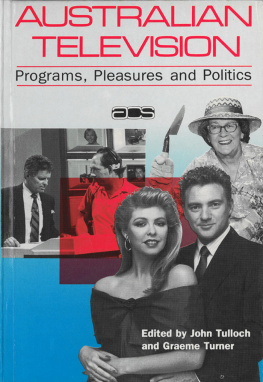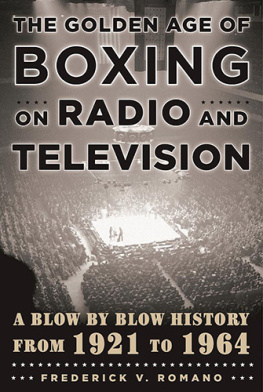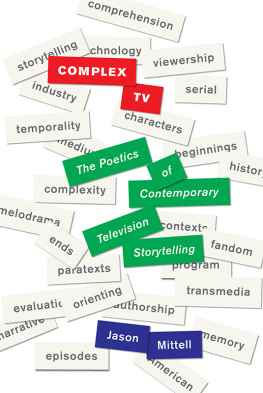
THE TELEVISION WILL BE REVOLUTIONIZED
The Television Will Be Revolutionized
Second Edition
Amanda D. Lotz

NEW YORK UNIVERSITY PRESS
New York and London
NEW YORK UNIVERSITY PRESS
New York and London
www.nyupress.org
2014 by New York University
All rights reserved
References to Internet websites (URLs) were accurate at the time of writing.
Neither the author nor New York University Press is responsible for URLs that may have expired or changed since the manuscript was prepared.
Library of Congress Cataloging-in-Publication Data
Lotz, Amanda D.
The television will be revolutionized / Amanda D. Lotz. Second edition.
pages cm Includes bibliographical references and index.
ISBN 978-1-4798-6573-4 (hardback) ISBN 978-1-4798-6525-3 (pb)
1. Television broadcasting. 2. Television broadcastingUnited States. 3. TelevisionTechnological innovations. 4. Television broadcastingTechnological innovations. I. Title.
PN1992.5.L68 2014
384.550973dc23 2014015124
New York University Press books are printed on acid-free paper, and their binding materials are chosen for strength and durability.
We strive to use environmentally responsible suppliers and materials to the greatest extent possible in publishing our books.
Manufactured in the United States of America
10 9 8 7 6 5 4 3 2 1
Also available as an ebook
For Wes, Sayre, and Calla
CONTENTS
PREFACE
Every book has its own story about the process of its creationcall it a books biography. Part of the biography of the first edition of The Television Will Be Revolutionized is that I returned the proofs to New York University Press three days after the birth of my first child, in July 2007. So watching that child head off to kindergarten in the fall of 2012 gave the age of the book an uncommon physical form. Oddly, it was easier to fathom that it was time for kindergarten than that the insights of the book were now five years old.
Much has happened in the television industry in these intervening years, though much has also remained unchanged. When the first edition went to press, I was playing around on the beta version of Huluthough there was little content, YouTube was still a start-up, the broadcast networks had clunky interfaces for streaming the very little content they made available, and there was nothing but movies or advertorials available through video on demand. A cable executive interviewed for this edition noted that the speed with which broadband-delivered video became ubiquitous caught even most industry insiders by surprise. Those on the forefront had tried out the slow-streaming, blocky, early ventures in this area and didnt think much of the experience. Then it all seemed to change overnight. Netflix, HBO GO, smartphones, tablets, TV Everywhere, oh my! The vast proliferation of content through various broadband providers is addressed in all of the books revised chapters, as it has affected every aspect of the industry and provides the biggest paradigmatic adjustment from the first edition.
The revised second edition updates developments throughout the television industry over the last seven years, focuses the book more on broad frameworks for thinking about these changes than on cataloging a multiplicity of initiatives and experiments, and makes general improvements upon certain aspects that I found suboptimal when I revisited it. In some places, details about the conditions of the industry in 2006 remain because they provide a valuable benchmark of the transition that allows the book to be a history of the present, while other details have been eliminated. Though many consider the book to be about the post-network era, I saw the contribution of the first edition primarily as a calling into existence and systematic explanation of the multi-channel transition period of the 1980s and 1990s. This context building prepares us to be able to talk about and theorize a post-network era and remains unchanged and unchallenged by the last seven years. The second revised edition maintains that contribution here and also expands on what can be said of the post-network era as it has come into greater relief. The structure and organization of the book remain largely intact; substantive adjustments are noted below.
It is the curse of a project like this to be inevitably out of date. During the time lag of the production process alone, new developments will occur. There are even developments that transpired before I submitted the manuscript that I elected to exclude because their consequences and likelihood of lasting impact, though potentially substantial, were not yet clear (Aereo; Chromecast). Here, Ive focused more on frameworks for understanding developments than on cataloging what different companies are doing in 2014 because of the inevitable change. For example, YouTube seems to have a new monetization strategy about every nine months, so instead of detailing the strategy in place at the moment of manuscript submission, I focus more on the industrial differences of advertising and subscription economic models and the consequences theyve produced for content in other media. I find my voice bolder here than in the first edition, but Im a conservative prognosticator by nature. Im more enamored with the consequences of new technologies, regulations, or economic strategies than with crystal ball gazing, and when teaching the book, am interested in encouraging my students to think about new developments in this way as well. It remains an obvious class assignment to have students investigate what has happened since the book was written; and Ill have done my job well if Ive given them enough tools here to make arguments about why, how, and to whom those changes matter.
When I first proposed the revision, I suspected I would need to add a great deal to the first version, but instead found a considerable amount I wished to cut. To me, the first edition now read as though the author felt she needed to prove her mettle on the topic by offering a detailed and exhaustive recounting of the vast experiments in each industrial processand that was probably the case. Here I rest on the reputation of my past work and do less to chronicle each new thing. Maybe Ive omitted something that will prove important in time, but the last seven years have offered countless lessons about television use, distribution, and financing, and I chose to focus more on areas now offering some evidence and consistency, rather than the most current thing. I dont doubt that a few years hence Ill either be back at this or well deem that a new book is needed and that this one has become a historical text. The frameworks the book uses for thinking about television are the parts that will live on regardless of further redevelopment of industry practices and changes in the companies that dominate them.
The introduction is now more succinct, and the detailed discussion of the different eras has been moved into the first chapter. In its place, I provide a new section that argues that we need to begin speaking of television content with more specificity when we consider the post-network era. I posit the categories of prized content, live sports and contests, and linear viewing as three such categorizations. I use these different ways of experiencing content throughout the book to illustrate how industrial adjustments affect each differently.
Except for the addition of the era explanations, remains the most unchanged. This book has been successful in reaching a variety of audiences, and this is the chapter that most marks it as a scholarly endeavorwhich makes it more and less interesting to different audiences. In some ways the distinction of phenomenal television that I offered in 2007 is now made more precise through discussion of prized content and live sports and contests, which are distinctions defined as much by viewer behavior as by content. Given that only a narrow group of early adopters experiences television in the ways made possible by post-network distribution technologies, it is difficult to think much further about the uses of television in the post-network era beyond what was possible in 2007.
Next page

